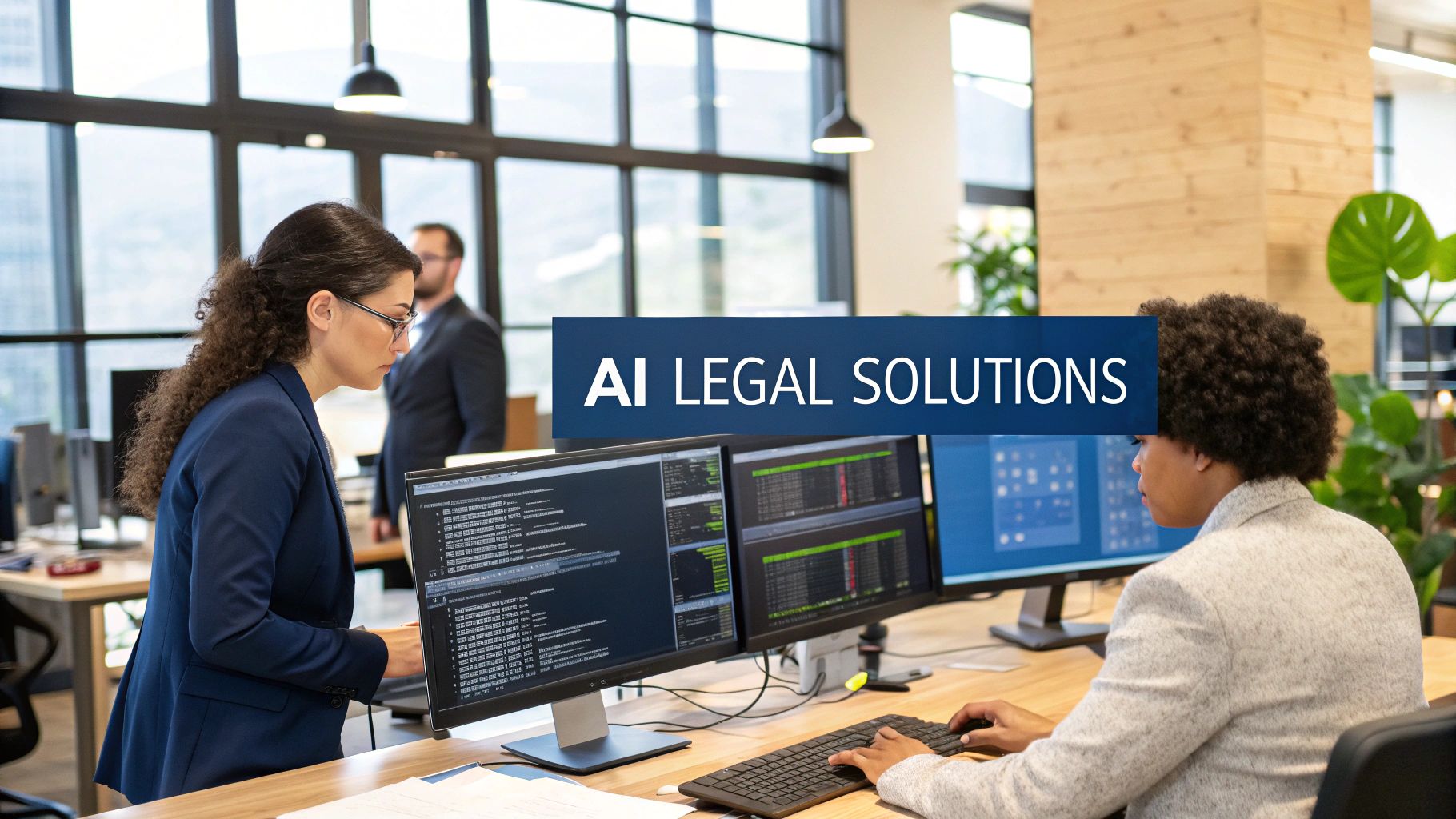Legal AI Software: Your Step-by-Step Guide to Transforming Law Practice
Navigating the Legal AI Revolution

The rise of AI software is reshaping how legal work gets done. This isn't just incremental change - it's a fundamental shift driven by growing demands for speed and precision in legal services. Recent market data shows the impact: the global legal AI software market reached $1.92 billion in 2023 and is expected to grow to $5.76 billion by 2029. For law firms, understanding and adopting AI tools is becoming critical to remain effective and competitive.
Understanding the Driving Forces
Several practical factors are pushing law firms to embrace AI solutions. Legal teams face mounting workloads and pressure to control costs while improving outcomes for clients. At the same time, breakthroughs in natural language processing (NLP) now allow AI systems to analyze legal documents with impressive accuracy. This opens up new possibilities for automating traditionally manual work. For instance, AI document review systems now achieve up to 95% accuracy, allowing firms to complete due diligence much faster while using fewer resources.
Real-World Impact of Legal AI Software
Law firms worldwide are seeing concrete benefits from AI adoption across key areas like document review, contract analysis, and legal research. In document review, AI can rapidly process huge datasets to spot key information and risks that would take humans far longer to identify. This frees up lawyers to focus on strategic work and client relationships. Similarly, AI contract analysis tools can find important clauses, potential issues, and compliance gaps - often reducing review time by 70%. The result is not just faster work, but more thorough and consistent analysis.
Balancing Innovation and Implementation
While AI offers clear advantages, successfully adding it to legal practice requires careful planning. Firms need to choose AI tools that match their specific needs and integrate smoothly with existing processes. Training staff effectively is vital - both on the technical aspects and in addressing concerns about changes to familiar workflows. The shift to AI may also mean rethinking traditional billing approaches as routine tasks become automated. By tackling these practical challenges head-on, firms can make the most of legal AI's capabilities while positioning themselves for long-term success as the field continues to advance.
Building Your Legal AI Technology Stack
Creating an effective AI system for legal work requires careful planning and selection of tools that work well together. Law firms need to thoughtfully build a collection of AI technologies that address their specific needs while integrating smoothly with how attorneys already work. Getting this foundation right is crucial for success with legal AI.

Key Components of a Modern Legal AI Suite
An effective legal AI system combines several essential tools that each handle specific tasks. When properly integrated, these components create a more efficient legal workflow:
- Document Automation: This core capability automatically generates standard legal documents like contracts and NDAs by pulling relevant information into templates. For example, rather than manually typing out contracts, lawyers can have the system create initial drafts using approved language and client details. This frees up time to focus on higher-value work like negotiations.
- Legal Research: AI research tools quickly scan vast databases of cases, statutes and regulations to find relevant legal precedents. When researching complex issues across jurisdictions, these platforms can rapidly compile relevant cases and materials that would take hours to find manually.
- Contract Analysis: Using natural language processing, these tools review contracts to spot key terms, potential issues, and suggest alternate wording. They can automatically identify inconsistencies, missing clauses, and unfavorable provisions that might otherwise be missed in manual review.
- eDiscovery: AI streamlines the process of finding, reviewing and producing electronic evidence for litigation. By automating document review, it dramatically reduces the time legal teams spend sifting through documents, allowing them to concentrate on case strategy.
Cloud-Based Solutions: The Dominant Force
Most legal AI tools now operate in the cloud, making them more accessible and cost-effective. Cloud platforms allow firms to easily adjust their AI capabilities as needed and access their tools securely from any location. This flexibility is especially valuable for firms with multiple offices or remote workers.
Integrating Components for Maximum Impact
The real power comes from connecting these AI tools into a unified system. Document review tools can achieve over 95% accuracy, while contract analysis can cut review time by 70%. When combined thoughtfully, these technologies create smooth workflows from research through drafting and review. Adding predictive analytics helps identify patterns in legal data that can guide strategy. By carefully implementing integrated AI solutions, firms can work more efficiently and serve clients better while maintaining high quality standards. The key is selecting tools that complement each other and support how lawyers actually work.
Mastering Generative AI in Legal Practice

Generative AI is changing how legal professionals work, offering new tools and capabilities that go beyond analyzing existing data to creating new content like legal documents, research summaries, and case analyses. For law firms looking to stay competitive, understanding how to effectively use this technology while maintaining high professional standards is essential.
Practical Applications of Generative AI in Law
Law firms are finding practical uses for generative AI across multiple areas of practice. In legal research, AI software can quickly search through case law databases and synthesize relevant information, helping lawyers find precedents and statutes more efficiently. For instance, what might have taken hours of manual research can now be accomplished in minutes. The technology also helps with document drafting - from contracts to briefs - by generating initial drafts based on provided parameters. This allows lawyers to focus more time on strategy and complex legal analysis. Additionally, AI tools can analyze case data to identify patterns and trends that may influence litigation strategy and case outcomes.
Maintaining Quality Control With Generative Legal AI Software
Quality control is critical when using AI in legal work. One key challenge is preventing AI "hallucinations" - instances where the system generates incorrect or nonsensical information. To address this, lawyers must learn effective prompt engineering techniques, providing clear and specific instructions to get accurate results. For example, instead of a vague request like "draft a contract," specify key terms, parties, and requirements. Regular human review of AI-generated content remains essential, with experienced lawyers checking for accuracy and legal soundness. Many firms are implementing systematic review processes to catch potential errors while still gaining efficiency benefits.
Ethical Considerations and Implementation Frameworks
Using AI in legal practice brings important ethical considerations. Client confidentiality and data privacy must be protected, requiring careful evaluation of AI tools and their security measures. Law firms need to select software that meets regulatory requirements and industry standards for data protection. There's also the challenge of ensuring AI outputs are fair and unbiased. If an AI system is trained primarily on cases from certain jurisdictions or time periods, it may produce skewed results. Forward-thinking firms are creating detailed ethical guidelines for AI use, covering everything from data handling to output verification. These frameworks help maintain professional standards while embracing new technology.
Training and Prompt Engineering for Legal Teams
Success with AI requires thorough training for legal staff. Teams need to understand both the capabilities and limitations of AI tools. Prompt engineering - writing effective AI instructions - has become a crucial skill. Just as lawyers carefully craft legal arguments, they must learn to craft precise AI prompts to get useful results. Many firms now have dedicated AI specialists who help optimize system use and train other staff members. This investment in training ensures teams can use AI effectively while maintaining high professional standards. Through proper training and implementation, law firms can use AI to enhance their practice while upholding their commitment to quality legal service.
Transforming Operations Through AI-Powered Efficiency

Law firms are reimagining their operations by incorporating AI software into their daily workflows. This goes beyond simply adding new tools - it represents a fundamental shift in how legal work gets done. By automating routine tasks, attorneys can now dedicate more time to complex legal analysis and client service. This evolution raises important questions about measuring the business impact of AI systems and adapting firm strategies accordingly.
Measuring the ROI of Legal AI Software
For firms evaluating legal AI tools, understanding the financial benefits is crucial. The key is focusing on specific, measurable metrics that demonstrate real value:
- Time Savings: Track hours saved on tasks like document review and contract analysis. Convert this into dollar savings based on attorney billing rates.
- Improved Accuracy: Measure reduction in errors for activities like legal research and due diligence. This helps avoid costly mistakes and improves outcomes.
- Increased Productivity: Monitor how automation allows attorneys to handle more work or spend additional time on complex matters. Higher productivity directly impacts revenue.
- Enhanced Client Satisfaction: Note improvements in turnaround times and work quality. Happy clients provide referrals and stay loyal, driving long-term growth.
For instance, if AI reduces document review time by 70%, a firm can calculate savings by multiplying the attorney's hourly rate by hours saved. They can also factor in new revenue from attorneys taking on additional cases.
Managing Client Expectations in the Age of AI
As AI becomes standard in legal practice, clear client communication is essential. Clients naturally have questions about how AI affects their matters. The key is transparency - firms should openly explain how they use AI software and the resulting benefits like faster service and lower costs. It's also important to emphasize that AI supports attorneys rather than replacing them. The human elements of strategic thinking and client relationships remain central to legal practice.
This means developing proactive communication strategies around AI use. Options include creating FAQ resources, hosting educational webinars, and having detailed discussions during client consultations.
Scaling AI Solutions Across Different Practice Areas
Many firms start with AI pilot projects in specific practice areas before expanding more broadly. Since each practice area has unique workflows, firms must carefully evaluate which AI tools fit different contexts and adjust implementation plans accordingly.
For example, a firm might first use AI-powered document review for litigation before expanding to contract analysis for transactions. This measured approach enables testing and refinement before wider rollout. It also provides concrete data on AI effectiveness across practice areas, building the case for continued investment and growth.
Ensuring Security and Ethical Compliance
Law firms adopting AI software must carefully balance technological advancement with secure and ethical use. This means putting strong safeguards in place while still taking advantage of AI's capabilities. Let's explore how successful firms are handling these important considerations.
Protecting Client Data and Confidentiality
Client data security requires special attention when implementing legal AI tools. Law firms handle highly sensitive information like case details, client communications, and strategic documents that must be protected from unauthorized access. Before adopting any AI software, firms should thoroughly assess security measures including data encryption, access controls, and compliance with regulations like GDPR and industry standards like SOC 2. Housing data in secure servers within the firm's jurisdiction adds another important layer of protection.
Addressing Ethical Concerns in AI Implementation
The ethical implications of using AI in legal work go beyond basic security considerations. A major challenge is preventing bias in AI-generated results. For example, if an AI legal research tool learns primarily from historical cases involving certain demographics, it may perpetuate those biases in its recommendations. Firms must also watch for "hallucinations" - where AI produces incorrect or nonsensical information. This highlights why human oversight remains essential for reviewing AI outputs and ensuring accuracy.
Implementing Practical Frameworks for Responsible AI Use
Clear communication about AI usage helps build client trust. Firms should create detailed policies explaining how they integrate AI into their work, what data they collect, and their quality control measures. Being upfront about AI use shows commitment to responsible practices. Establishing clear accountability for AI-driven work helps maintain professional standards within the firm.
Building Trust Through Transparency and Accountability
Many firms now have internal committees overseeing AI implementation. These groups provide ethical guidance, review policies, and confirm AI applications match firm values. Ongoing staff training about AI ethics helps create a culture of responsible technology use. When firms combine strong security, ethical oversight, and transparency, they can successfully use AI while maintaining client trust and meeting professional obligations. The key is taking a thoughtful, systematic approach that puts client interests first.
Building a Future-Ready Legal Practice
Law firms are adapting their practices as legal AI software becomes increasingly central to their work. Success requires careful planning around staff development, optimizing operations, and planning for what's next. Let's explore key strategies for building a legal practice ready for the changes ahead.
Developing AI-Ready Talent
Legal professionals need new capabilities to effectively work with AI tools. Beyond basic technical know-how, lawyers and staff need to understand both what AI can and cannot do. For instance, crafting effective prompts for AI systems requires skills similar to constructing legal arguments - precise language and logical structure are essential. Legal teams also need expertise in AI ethics and professional responsibility. Smart firms are investing in comprehensive training programs, not just to keep up with technology, but to enable their teams to serve clients better and work more productively.
Building Scalable Processes
Making the most of legal AI means rethinking how work gets done. Tasks like document review and contract analysis can now be automated, letting lawyers focus on strategic work and client relationships. Well-designed processes help firms handle growing volumes of legal data more effectively, with AI tools surfacing insights that would be hard to find manually. This improved efficiency opens up new possibilities - for example, firms can offer predictable flat-fee arrangements for certain services, making legal help more accessible to clients.
Staying Ahead of Emerging Trends
Legal AI capabilities continue to expand rapidly. As new tools and features emerge, firms need to evaluate what will truly benefit their practice. This requires ongoing education and flexibility. For example, advances in AI are reshaping core activities like legal research, document creation, and client communication. The firms that thrive will be those that thoughtfully adopt helpful new technologies while maintaining their focus on excellent client service. By staying informed about emerging trends, practices can spot both challenges and opportunities early, fostering a culture of smart innovation. This forward-looking mindset helps firms deliver consistently excellent client value even as the legal landscape evolves.
Want to experience the benefits of AI in your legal practice? Explore Whisperit, the AI dictation and text editing platform trusted by legal professionals for enhanced efficiency and data security. Visit https://whisperit.ai today to improve your workflow.